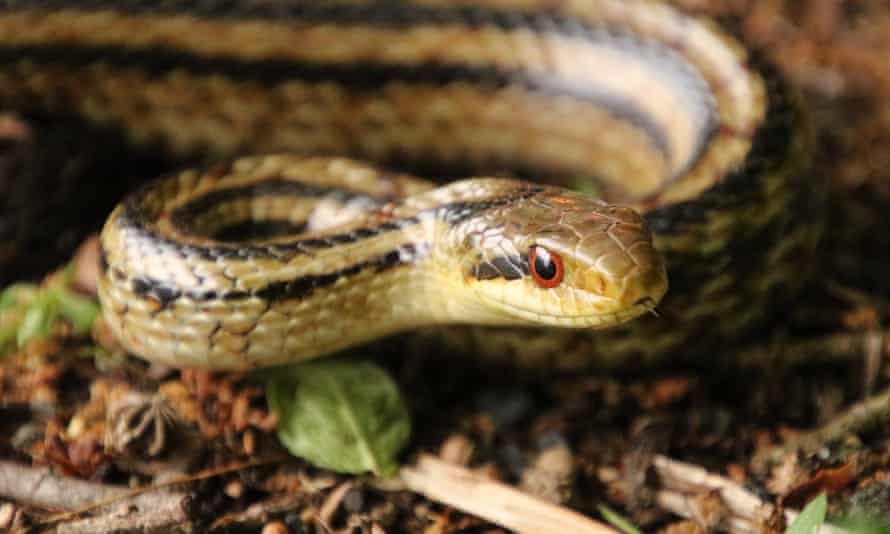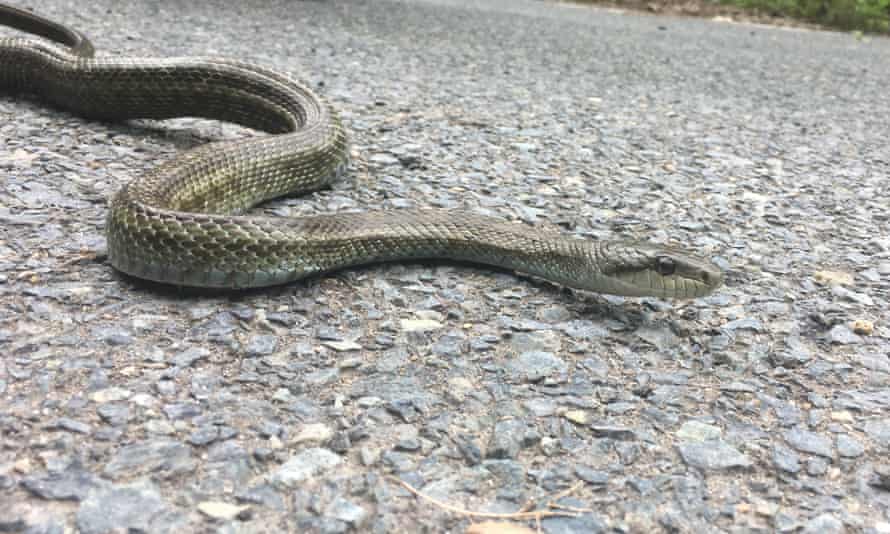https://www.theguardian.com/world/2...nitor-fallout-from-fukushima-nuclear-disaster
Glue and duct tape used to fit rat snakes with dosimeters and GPS movement trackers to help researchers understand long-term effects of radiation

The snake study is another piece of the puzzle in trying to understand the long-term effects of radiation exposure in Fukushima and elsewhere. Photograph: Hannah Gerke
Gavin Blair in Tokyo
Thu 9 Sep 2021 09.11 AEST
Researchers have used snakes fitted with tracking devices and dosimeters to measure radiation levels in the area around the Fukushima Dai-ichi nuclear plant, which suffered triple meltdowns in March 2011.
The meltdowns in Japan caused by a giant tsunami released more radiation into the atmosphere than any nuclear disaster except Chernobyl in 1986.

Around 150,000 people were forced to flee in the immediate aftermath of the accident and though many have returned, an area of nearly 400 square kilometres is still deemed unfit for human habitation.
The snake study is another piece of the puzzle in trying to understand the long-term effects of radiation exposure in Fukushima and elsewhere.
“Snakes are important in many ecosystems as they can be both predators and prey,” explained Hannah Gerke, one of the lead researchers.
The scientists captured dozens of the reptiles, most of them rat snakes, and fixed dosimeters and GPS movement trackers to them with duct tape and superglue. They were then able to monitor the levels of radiation, primarily radiocesium 134 and 137, in the snakes depending on their location and movements.
Due to the limited distances they travelled within their home environments approximately 24 kilometres (15 miles) from the nuclear plant and the differing times they spent in trees and closer to contaminated soil, the snakes provided useful biomarkers that showed radiation exposure.

Fukushima disaster: first residents return to town next to nuclear plant
Read more
The researchers found that snakes inside the Fukushima exclusion zone (where people are recommended not to live) showed whole body radiocesium levels around 22 times higher than those from outside.
“Radiocesium 134 and 137 tends to bind to soil and accumulates in the muscle tissue of snakes,” explained Gerke. “But we don’t understand what level would be harmful.”

Photograph: Hannah Gerke
Gerke said that levels of radioactive contamination were much lower now than they were immediately after the accident due to the natural decay of contaminants over time. The radiation levels were also found to vary greatly across different terrains, even in locations that were quite close together, meaning that radioactive materials from the disaster had not fallen or accumulated evenly across the affected areas.
The monitoring of the snakes was carried out during the summer of 2018 and the results published in the Ichthyology and Herpetology journal this summer.
Though research has been carried out on the effects of radiation on various types of mammal, this study was the first done on snakes.
The scope of the study didn’t cover the impact on the snakes themselves, something that Gerke said “definitely needs more work”.
Glue and duct tape used to fit rat snakes with dosimeters and GPS movement trackers to help researchers understand long-term effects of radiation

The snake study is another piece of the puzzle in trying to understand the long-term effects of radiation exposure in Fukushima and elsewhere. Photograph: Hannah Gerke
Gavin Blair in Tokyo
Thu 9 Sep 2021 09.11 AEST
Researchers have used snakes fitted with tracking devices and dosimeters to measure radiation levels in the area around the Fukushima Dai-ichi nuclear plant, which suffered triple meltdowns in March 2011.
The meltdowns in Japan caused by a giant tsunami released more radiation into the atmosphere than any nuclear disaster except Chernobyl in 1986.

Around 150,000 people were forced to flee in the immediate aftermath of the accident and though many have returned, an area of nearly 400 square kilometres is still deemed unfit for human habitation.
The snake study is another piece of the puzzle in trying to understand the long-term effects of radiation exposure in Fukushima and elsewhere.
“Snakes are important in many ecosystems as they can be both predators and prey,” explained Hannah Gerke, one of the lead researchers.
The scientists captured dozens of the reptiles, most of them rat snakes, and fixed dosimeters and GPS movement trackers to them with duct tape and superglue. They were then able to monitor the levels of radiation, primarily radiocesium 134 and 137, in the snakes depending on their location and movements.
Due to the limited distances they travelled within their home environments approximately 24 kilometres (15 miles) from the nuclear plant and the differing times they spent in trees and closer to contaminated soil, the snakes provided useful biomarkers that showed radiation exposure.

Fukushima disaster: first residents return to town next to nuclear plant
Read more
The researchers found that snakes inside the Fukushima exclusion zone (where people are recommended not to live) showed whole body radiocesium levels around 22 times higher than those from outside.
“Radiocesium 134 and 137 tends to bind to soil and accumulates in the muscle tissue of snakes,” explained Gerke. “But we don’t understand what level would be harmful.”

Photograph: Hannah Gerke
Gerke said that levels of radioactive contamination were much lower now than they were immediately after the accident due to the natural decay of contaminants over time. The radiation levels were also found to vary greatly across different terrains, even in locations that were quite close together, meaning that radioactive materials from the disaster had not fallen or accumulated evenly across the affected areas.
The monitoring of the snakes was carried out during the summer of 2018 and the results published in the Ichthyology and Herpetology journal this summer.
Though research has been carried out on the effects of radiation on various types of mammal, this study was the first done on snakes.
The scope of the study didn’t cover the impact on the snakes themselves, something that Gerke said “definitely needs more work”.



